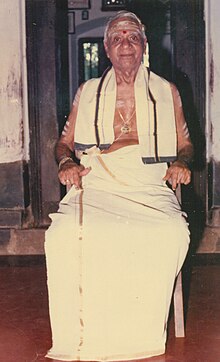Nāṭyācārya Padma Śrī Mani Madhava Chakyar Vidūṣakaratnaṁ | |
|---|---|
 Mani Madhava Chakyar | |
| Born | 15 February 1899 |
| Died | 14 January 1990 (aged 90) Ottappalam, Kerala, India |
| Years active | 1910–1990 |
| Spouse | P. K. Kunjimalu Nangiaramma |
| Awards | 1964: Sangeet Natak Akademi Award 1964: Paderewski Foundation (New York) Certificate of Merit 1974: Padma Shri 1975: Kerala Sahitya Akademi Award 1976: Kerala Sangeetha Nataka Akademi Fellowship 1982: Sangeet Natak Akademi Fellowship 1982: Govt. of India Emeritus Fellowship 1982: Kalidasa Academy Fellowship 1983: Kerala Kalamandalam Fellowship 1987: Tulsi Samman 1991: Guruvayoorappan Sammanam |
Guru Mani Madhava Chakyar (IAST: Māṇi Mādhava Cākyār) (15 February 1899 – 14 January 1990) was a celebrated master performance artist[1] and Sanskrit scholar [2] from Kerala, India, considered to be the greatest Chakyar Koothu and Koodiyattam (ancient Sanskrit drama theatre tradition) artist and authority of modern times.[3][4] He was considered as the authority of Abhinaya (the classical Indian acting style) and Nātyaśāstra.
Known as "the Emperor of Rasa-Abhinaya",[5] he had an exceptional ability to perform Rasa-Abhinaya.[6] His Netrābhinaya[7] was world-famous and he had the ability to act only with eyes. He was well versed in all the traditional Koodiyattams and all the prabandhas used in Chakyar Koothu. He was able to explain the concepts, methods and practices of Koodiyattam and Chakyar Koothu in a clear and authentic way. He had an in depth study of Nātyaśāstra of Bharata Muni, as well as ways of acting which were popular in Kerala. His knowledge and mastery over both theory and practice of Koodiyattam were superb. He was a veteran teacher and practitioner of these art forms and Sanskrit.[8]
He was the first one to take Koodiyattam and Chakyar Koothu outside the precincts of the temples of Kerala to all over India and to impart training in Kudiyattam to non-Chakyar disciples including foreigners. He had produced many disciples in Kutiyattam and other classical arts like Kathakali.[4] He was a Sanskrit scholar and was used to give lectures and talks in Sanskrit.
He is the author of Nātyakalpadrumam – an encyclopaedic treatise on all aspects of Koodiyattam. He was a Fellow of national art academies including Sangeet Natak Akademi[9] and recipient of coveted titles like "Nātyāchārya", "Vidūshakaratnam" and awards including Padma Shri and Sangeet Natak Akademi Award.
- ^ Cultural News from India, Indian Council for Cultural Relations, Govt. of India, 1982, p. 77
- ^ Tripathi, Radha Vallabh, ed. (2012), INVENTORY OF SANSKRIT SCHOLARS, RASHTRIYA SANSKRIT SANSTHAN, New Delhi, p. 38, ISBN 978-93-86111-85-2
- ^ "Spectrum". The Sunday Tribune, 16 April 2006. Archived from the original on 30 September 2007. Retrieved 29 June 2007.
- ^ a b Lal, Ananda, ed. (2004), The Oxford Companion to Indian Theatre, Oxford University Press, USA, pp. 75–76, ISBN 978-0-19-564446-3
- ^ Akavur Narayanan, Shatam Jiva Sharadah, Mathrubhumi weekly, March (15–21) 1987, p. 20.
- ^ enacting different sentiments in their perfection
- ^ enacting different sentiments, etc. through the beautiful and masterly movements of eyes only
- ^ "On a mission of a cultural sort". The Hindu. 17 June 2005. Archived from the original on 26 October 2007. Retrieved 21 July 2007.
- ^ supreme state art academy of Govt. of India